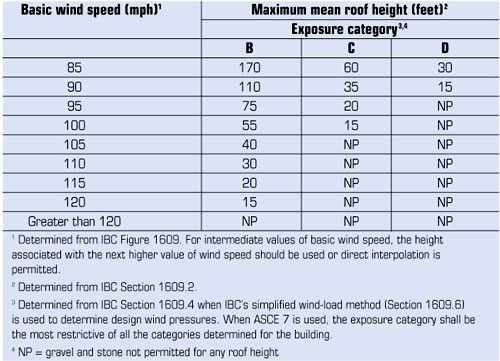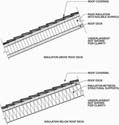Recently, model building codes have enacted restrictions regarding the use of aggregate as a top surfacing for low-slope membrane roof assemblies. Such restrictions may affect the installation of low-slope membrane roof assemblies.
Following is the rationale for these restrictions and a review of the specific restrictions.
Wind-borne debris
Since the early 1990s, model building codes have taken strides to strengthen buildings' resistances to high-wind pressures, such as those experienced during hurricanes. At the same time, insurance industry representatives and some wind experts also have lobbied for code restrictions intended to limit wind-borne debris during high-wind events.
During high-wind events, wind-borne debris sometimes penetrates buildings' exterior envelopes, breaking windows and resulting in property loss and possible internal pressurization, which can result in massive building failures. Roofing aggregate is viewed as a large portion of wind-borne debris.
Code restrictions
The 1996 and 1999 editions of The BOCA National Building Code (BNBC) contain provisions that require rooftop surfacing aggregate to be tested and shown to stay in place when subjected to a building's design basic wind speed. To date, no recognized methodology exists for testing the wind resistances of aggregate surfacings. Therefore, there appears to be no practical means of complying with BNBC's requirement.
In the National Fire Protection Association's NFPA 5000: Building Construction and Safety Code, 2003 Edition, a requirement stipulates roofing aggregate shall not be used on buildings taller than 60 feet (18 m) or any building located in a hurricane-prone region.
The code goes on to define hurricane-prone regions of the United States and its territories as areas along the Atlantic Ocean and Gulf of Mexico where the basic wind speed is 90 mph (40 m/s) or greater and American Samoa, Guam, Hawaii, Puerto Rico and the U.S. Virgin Islands.

IBC 2006's maximum allowable use of aggregate surfacings for roofs outside hurricane-prone regions
The International Code Council (ICC) approved a code change that prohibits the use of roofing aggregate on buildings in hurricane-prone regions or any building exceeding the requirements listed in the figure.
Barring revision of this code language during ICC's 2004-05 code-development cycle, ICC's roofing aggregate restriction first will appear in ICC's 2006 edition of the International Building Code.®
Closing thoughts
Recently enacted code restrictions regarding the use of aggregate surfacings likely will significantly affect the use of aggregate-surfaced, low-slope membrane roof assemblies in many U.S. regions.
If you are involved in the installation of aggregate-surfaced built-up, aggregate-ballasted single-ply or other roof system types that use aggregate top surfacings, I encourage you to be aware of these pending code restrictions.
Mark S. Graham is NRCA's associate executive director of technical services.

